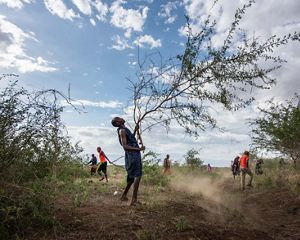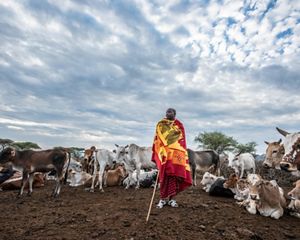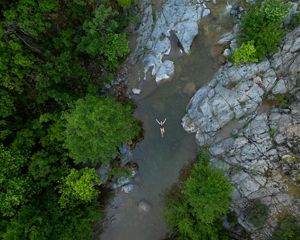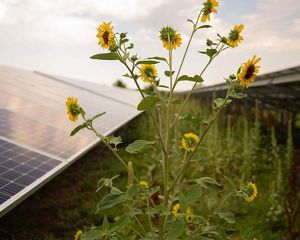Grasses Are Everything
Warda Kanagwa, TNC’s livestock and grazing officer in northern Tanzania, helps the Maasai people conserve critical grasslands.
Text by Suzanne Goldsmith | Photograph by Roshni Lodhia | Issue 2, 2024

In Northern Tanzania, grasses are everything. Communities, including the Maasai, rely on the native grasses to feed their cattle—the same grasses elephants, wildebeests and other big mammals graze upon too. As the grasses face growing pressure from increasing numbers of livestock and from invasive grasses that crowd out native species, Warda Kanagwa, TNC’s livestock and grazing officer in the area, is working with others at TNC and with community members to give the grasses a fighting chance.
Suzanne Goldsmith: You work with the Maasai people in northern Tanzania to maintain healthy grasslands for both cattle and wildlife like elephants, wildebeests and other large mammals. What’s the importance of cattle in Maasai culture?
Warda Kanagwa: In part, the Maasai keep cattle for prestige. The more cattle you have, the more you are respected in the community. But it’s not only for prestige; they keep cattle for their livelihood. They keep them for milk, which is the food they depend on most. The Maasai can drink milk in the morning, in the afternoon, even the evening without eating anything else. The cattle also provide meat and manure. And sometimes they sell the cattle to buy maize, beans and other food for their families.
SG: And those cattle rely on native grassland, right?
WK: Grasses are everything to the Maasai people because the cattle survive mainly on grasses. But there is growing pressure on the grasslands. Random grazing can lead to overgrazing and degradation of the soil, which can in turn lead to an increase in bare land and the spread of unpalatable grasses and invasive species.
SG: Some of that pressure comes from an increasing number of livestock, some from invasive plants crowding out native species. What are some strategies you encourage for grassland preservation?
WK: We teach communities how to divide their grazing land into blocks. Then, when you graze your livestock during the dry season, you make sure that you finish grazing one block before you enter another block. [This gives each area a chance for new grass to grow undisturbed.] The Maasai used to do this in the past, but they have forgotten. So we are trying to bring it back.
SG: How do you do that?
WK: Working to change people’s mindset, it’s quite challenging. Not only with the Maasai, but in any community. They adapt slowly.
TNC started doing this in 2018, before I was there, working with three villages. And soon other communities began asking, “What are you doing? Why do you have the grasses during the drought season?” They would answer, “We are using the holistic planned grazing, which TNC taught us about.” They started with three villages, but now it’s in 33 villages.
In every village we have three representatives. We call them grazing coordinators. We bring them together quarterly for a workshop. There, you can find the grazing coordinators from X village learning from Y village. We bring them together so they can exchange ideas.
SG: You also have expertise in the control of invasive plant species, which are threatening to crowd out the native grasses.
WK: We have three major invasive species we are dealing with: Parthenium hysterophorus [or Santa Maria feverfew]; Dichrostachys cinerea, or sickle bush; and Ipomoea hildebrandtii, also known as morning glory or moon flower.
My master’s degree thesis was on invasive species control. So when I came to TNC, I began working with communities, teaching them these skills. The methodology we are using to control the invasive species in this region is primarily manual removal—mechanical uprooting. We have uprooted about 3,000 acres of invasive species. Some of our partner organizations have adopted our methodology and are applying it to other villages, bringing the total to 7,000 acres uprooted since 2020.
Nowadays, when we have money, for example, to uproot 40 acres of invasive species, the community will often say, “If you pay for 40 acres, we will add another 40 acres.”
Quote
Random grazing can lead to overgrazing and degradation of the soil, which can in turn lead to an increase in bare land and the spread of unpalatable grasses and invasive species.
SG: Your work supports not only livestock but also the iconic wildlife that rely on the same grasses. How do TNC’s programs support these animals?
WK: We work [to protect grasslands] outside national parks, because wildlife spends its time outside protected areas. For example, in the Randilen Wildlife Management Area, which TNC supports, cattle graze, but wildlife depend on it as well. It is popular for photography tourism. The tourists pay an entry fee. There are lodges. And some of the money tourists spend there goes out to communities, where they use it to build clinics, to build schools, to support scholarships for kids.
SG: Do you have a personal connection to this work?
WK: I grew up in a farming family in northwest Tanzania. My father was a livestock keeper. He had a ranch. I did a bachelor’s degree in wildlife management and a master’s in life sciences, specializing in biodiversity conservation and ecosystem management.
SG: Were you aware, growing up on a cattle ranch, of the problems that you are seeking to address in your work today?
WK: To be honest, I didn’t know. When I was helping my dad back then, it was all from my heart, helping my dad to increase the number of cattle. I knew when my dad sold this cattle it would pay for school fees for all five of his children. [It would] make sure that we got a good education. I didn’t know the meaning of “carrying capacity” then—the number of livestock a certain area can support. But after my first degree, I started understanding what my dad was doing. I began advising him, and he’s now doing things in a better way. I said, “You cannot increase the number of cattle on this size of the land. You have to increase the land first, then you increase the number of cattle.”
Before my degree, I think he had about 500 cattle, but he has increased the size of the ranch, and he now has about 15,000 cattle.
SG: You have been working at this for more than two years. Have there been any moments where you felt like you were seeing the fruit of all this labor?
WK: Last year our colleagues from the U.S. visited us here in northern Tanzania, and we took them to a field where we have uprooted invasive species. We went to an area that I hadn’t visited for maybe six months. And we found a lot of grasses and a lot of elephants there. I was like, “Oh my God, this area was all covered with invasive species. Now you can see there are a lot of grasses.” I felt amazing. We are creating healthy wildlife. That’s what I see when I go out.
About the Creators
Suzanne Goldsmith is based in Columbus, Ohio. She is the author of two books and is a former editor for Columbus Monthly.
Roshni Lodhia is a photographer and filmmaker whose upbringing in Tanzania inspired her to create visual stories for conservation organizations including The Nature Conservancy.
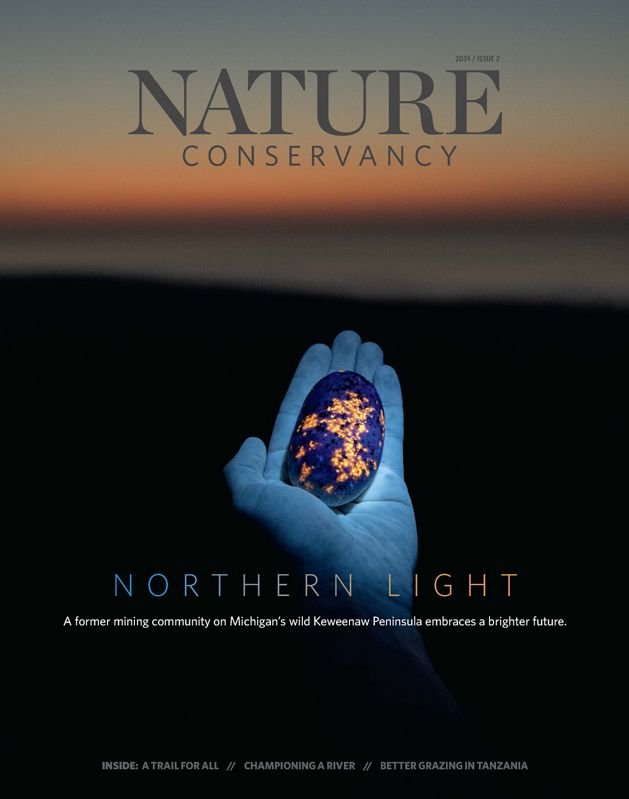
Magazine Stories in Your Inbox
Sign up for the Nature News email and receive conservation stories each month.
